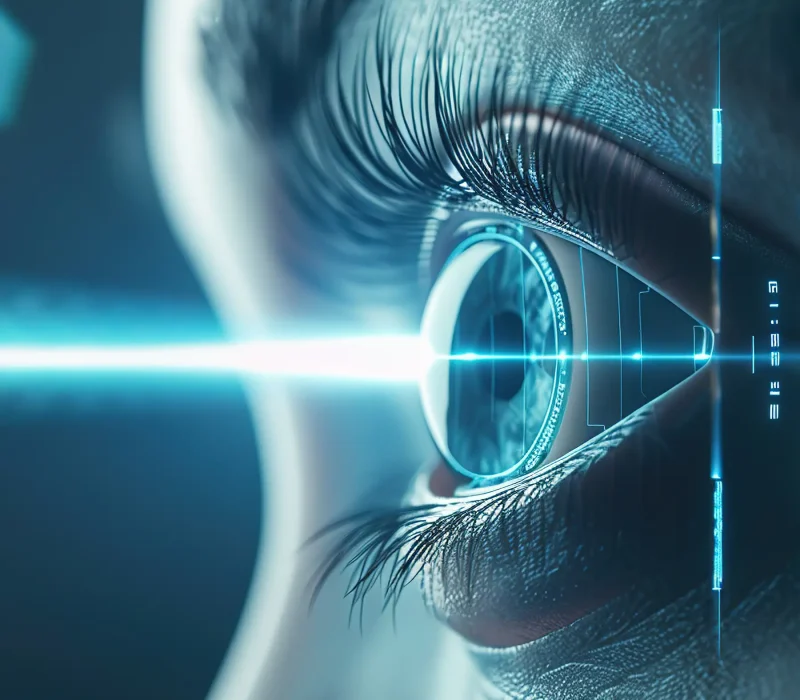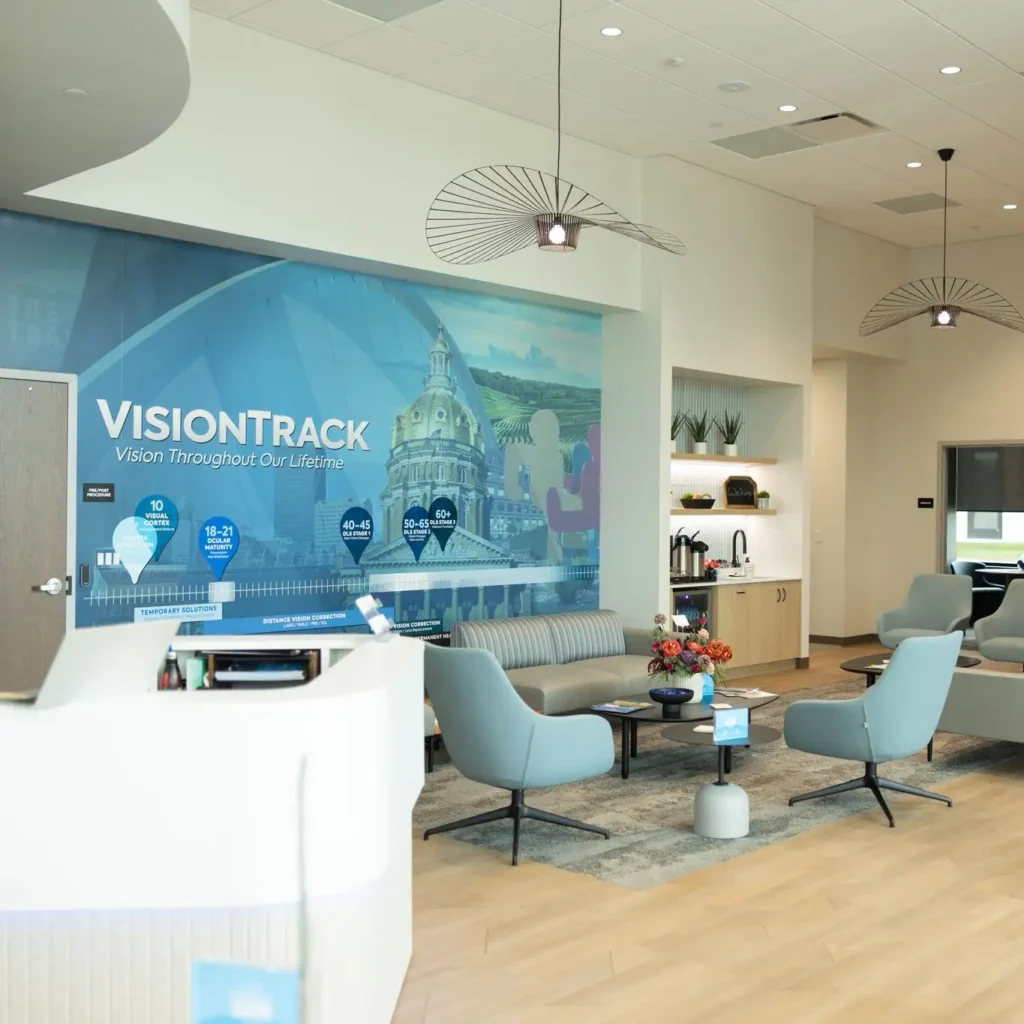Blended Vision
Experience life with clearer vision—discover how LASIK at MVC offers safe, proven, and life-changing freedom from glasses and contacts.

What is Blended Vision?
Blended vision is a refractive strategy used to help reduce dependence on reading glasses or bifocals, especially in patients with presbyopia. It works by correcting one eye—typically the dominant one—for distance vision and the other for near or intermediate vision, while creating a transitional “blend zone” that allows both eyes to function together more smoothly than in traditional monovision. At MVC, this approach is used in a range of advanced procedures, including LASIK, PRK, Refractive Lens Exchange (RLE), EVO ICL, and cataract surgery. By slightly adjusting the focal target of each eye and enhancing depth of field, blended vision helps patients maintain clear vision across multiple distances with less difficulty adapting, making it a practical and modern solution for age-related near vision loss.
- Safe & Effective
- Minimally Invasive
Why Choose MVC for Blended Vision?
- Vision Correction Specialists: LASIK, SMILE, or advanced lenses—modern vision correction is our exclusive focus.
- All 7 Modern Vision Options: Unlike places that offer only LASIK, we offer all 7 modern laser vision correction options—so you get the procedure that’s right for your eyes.
- In-Depth Eye Exams: Our EyeAnalysis provides the region’s most detailed eye health evaluation—front to back, top to bottom.
- Expert-Certified Team: Our surgeons include fellows certified by the World College of Refractive Surgery and Visual Sciences.
- Exceptional Patient Experience: Relax in our welcoming spa-like clinic—enjoy no wait times and personalized care from start to finish.
- Award-Winning Excellence: Built on Kugler Vision’s patient-first standards—a decade-long Best of LASIK practice winner.

Your Clear Vision Starts Here
Take the first step—see if you're a candidate now.
Meet Your MVC Blended Vision Surgeon
Dr. Drew Dickson is the only World College of Refractive Surgery and Visual Sciences certified vision correction specialist in the state of Iowa. He specializes in LASIK, SMILE, and lens-based procedures, delivering trusted results through precision, experience, and patient-first care.

Our Blended Vision Eye Surgery Locations

Who is a candidate for Blended Vision?
Blended vision is suitable for most people over age 40–45 experiencing presbyopia and wanting to reduce their reliance on glasses. At MVC, candidate eligibility is determined through a detailed evaluation of vision needs, ocular health, and tolerance to the blended vision strategy. Candidates typically meet the following criteria:
- Age: Most candidates are over 40, as presbyopia usually develops between ages 40 and 45.
- Symptoms: Needing reading glasses, bifocals, or multifocal lenses for close-up tasks.
- Vision Status: Suitable for individuals with myopia (up to -8.50D), hyperopia (up to +6.00D), astigmatism, or those with good distance vision but trouble seeing up close.
- Spectacle Independence: A strong desire to reduce or eliminate the use of glasses for near and distance vision.
- Ocular Health: Eyes must be healthy and free from disease or conditions that could impact healing or outcomes.
- Corneal Thickness: Adequate thickness is required for LASIK or PRK; thinner corneas may be better suited for RLE or EVO ICL.
- Dominance and Tolerance: Eye dominance is tested, and patients must pass cross-blur tolerance assessments to confirm comfort with blended vision.
- Adaptability: Blended vision has a high adaptation rate, with 95–97% of presbyopic patients found to be good candidates.
Benefits of Blended Vision
- Clear vision at multiple distances: Allows patients to see well at near, intermediate, and far ranges without needing to switch between different pairs of glasses.
- Less reliance on glasses or contacts: Most people can go about daily tasks like reading, driving, or using screens without visual aids.
- Maintains depth perception: Preserves more natural binocular vision compared to traditional monovision, helping with balance and spatial tasks.
- Smooth brain adaptation: The brain adjusts quickly to the slightly different focus in each eye, creating a seamless visual experience.
- Personalized to each patient: Treatments are customized based on eye dominance, refractive error, and other eye characteristics for optimal results.
- Lasting results: Provides stable improvement in vision as presbyopia progresses, making it a long-term solution.
- High satisfaction rates: Most patients report better quality of life and are pleased with their ability to see clearly without constant use of glasses.

State of the Art Technology
MVC uses the most advanced technology available to provide the safest and most precise vision correction possible. The right technology leads to better outcomes, which is why we invest in state-of-the-art equipment to ensure every patient gets the best results. Unlike providers who provide discounted vision correction procedures, MVC believes every patient deserves the highest level of care without compromise.

How does Blended Vision work?
Blended vision works by giving each eye a different job—one eye is set to see better at a distance, and the other is adjusted to be better with things up close or at arm’s length. At MVC, this approach is used in several types of vision correction procedures to help reduce or even eliminate the need for reading glasses.
In LASIK and PRK, the surface of each eye is gently reshaped with a laser to create these different focus points. The adjustments are made in a way that still lets both eyes work well together, especially for tasks in the middle range like using a computer. This creates smoother, more natural vision than older methods like monovision.
With Refractive Lens Exchange or cataract surgery, the eye’s natural lens is removed and replaced with an artificial one. Different lens strengths are chosen for each eye—one for seeing far away, and the other for seeing up close. Newer types of lenses can also help stretch the range of vision even more.
In EVO ICL, a small lens is placed inside the eye without removing the natural one. Like with other methods, one eye gets a lens for distance and the other for near or intermediate vision. This allows both eyes to team up for clear vision at a variety of distances, making everyday tasks easier without constantly reaching for glasses.
our reviews
Our Patients Love What We Do
Hear from real patients whose lives have been transformed by clearer vision and compassionate, expert care at MVC.
Modern Vision Correction was incredible from the moment I walked in. The LASIK surgery was fast, painless, and I had perfect vision the very next day. Can’t believe I waited this long.
Matthew M.
LASIK Patient
Dr. Dickson and his team got me in quickly for LASIK, made the process easy, and I’m seeing 20/15 now. Absolutely amazing!
Ellie R.
LASIK Patient
I had SMILE performed today, and couldn’t be happier. Dr. Dickson walked me through everything, and even called me later to check in. Incredible experience!
Cody N.
SMILE Patient

What makes Blended Vision a more natural alternative to traditional presbyopia treatments?
Blended vision is a more natural alternative to traditional presbyopia treatments because it creates a smoother, more continuous range of focus that closely mimics how the eyes functioned before age-related changes set in. Unlike monovision, which can cause a disconnect between the eyes and lead to blur at middle distances, blended vision allows both eyes to work together across near, intermediate, and far distances. This preserves better depth perception and makes everyday activities like reading, driving, or using a computer feel more natural. The brain adapts more easily to blended vision, which reduces the eye strain or imbalance some people feel with monovision or multifocal lenses. Blended vision can also avoid common problems like glare or halos often associated with multifocal intraocular lenses. Because the treatment is customized to your specific vision needs and lifestyle, it results in a more balanced and comfortable visual experience—similar to how your eyes used to work before presbyopia.
Which refractive surgery procedures can be used with Blended Vision?
LASIK
Yes, Blended Vision is commonly done with LASIK.
- One eye is corrected for distance, the other for near.
- Great option for Dysfunctional Lens Syndrome (DLS) patients, often aged in their early 40’s and older.
SMILE
Generally, no, Blended Vision is not compatible.
- SMILE doesn’t allow for the same customization as LASIK/PRK.
- Off-label or emerging options may arise, but currently it’s not widely used for Blended Vision.
PRK
Yes, Blended Vision is also possible with PRK.
- Similar approach to LASIK, but surface-based procedure.
- Often chosen when LASIK isn’t suitable due to thin corneas or other reasons.
EVO ICL
Yes, blended vision is possible with the EVO ICL.
- EVO ICL is best for correcting distance vision.
- Blended Vision with ICL is not standard, but can be used in patients struggling with their near vision.
Refractive Lens Exchange
Yes, Blended Vision is frequently used in RLE.
- Involves replacing the natural lens with two lenses aimed at distance and near.
- Alternatively, a multifocal or extended depth of focus (EDOF) lens can be used instead.
Laser Cataract Surgery
Yes, Blended Vision is a standard option.
- Often chosen if multifocal lenses aren’t ideal.
- Like RLE, one lens is for distance, the other for near or intermediate.
FAQ's About Blended Vision
How long does it take to adjust to blended vision after surgery?
There are different stages to adapting to blended vision. Most patients function well right away, but it can take a few days up to a few months to fully adapt, depending on how quickly their brain adjusts to using each eye for different distances. Most patients have fully adapted to blended vision within 2-3 months. MVC carefully evaluates your ocular dominance and performs pre-surgery tolerance testing to ensure you’re likely to adapt well. Because both eyes still work together, most people find the adjustment period shorter than with traditional monovision.
Can blended vision be done with SMILE surgery?
Blended vision is generally not recommended with SMILE because the procedure doesn’t allow for the same level of customization as LASIK or PRK. At MVC, we do not typically use SMILE for monovision or blended strategies because it cannot precisely tailor one eye for near and the other for distance vision the way laser blended vision treatments can. While future innovations may expand its use, SMILE is not currently a common method for achieving blended vision.
Is blended vision permanent?
Yes, blended vision is a long-term solution, especially when performed using laser surgery, refractive lens exchange, or intraocular lens implants during cataract surgery. At MVC, we provide lasting results by selecting the most appropriate technique and technology based on your unique vision and long-term goals, reducing the need for glasses or a contact lens later on.
What happens if I don’t like blended vision after surgery?
If you don’t adapt well to blended vision, there are options to adjust or reverse the treatment. At MVC, we give you all the information upfront, including the possibility of enhancement procedures or switching to another vision correction method. Our goal is to optimize your visual acuity and comfort, even if that means revisiting your surgical plan.
Does blended vision work well for people with astigmatism?
Yes, blended vision can be effective for people with astigmatism. At MVC, we use advanced diagnostics to guide precise corrections, allowing each eye to handle specific visual tasks while minimizing distortions across the visual field.
How does blended vision affect activities like watching television?
Blended vision is designed to provide a smooth range of vision across all distances, so tasks like watching television, reading, or working on a computer generally feel natural. MVC evaluates your lifestyle needs during your consultation to make sure your treatment supports activities that are important to you.
Is there an age limit for blended vision surgery?
Blended vision is most commonly recommended for people over 40 experiencing presbyopia, but there’s no strict upper age limit. At MVC, we assess overall eye health, refraction stability, and any signs of eye disease before recommending treatment. Age alone isn’t a disqualifier if your eyes are healthy and your goals align with the benefits of blended vision.
Will I still need reading glasses with blended vision?
Many patients who choose blended vision at MVC no longer need reading glasses for most daily activities. However, in some cases, you might still prefer glasses for fine print or long periods of close-up work. The goal of blended vision is to reduce dependence on any corrective lens, and most patients experience strong visual freedom across a wide range of distances.
Can blended vision correct both near-sightedness and presbyopia?
Yes, blended vision can address both near-sightedness and presbyopia by correcting one eye for distance and the other for near or intermediate tasks. The ophthalmology team at MVC evaluates your specific vision needs to design a treatment plan that provides clear, comfortable sight at all ranges.
Is blended vision right for someone who works with images or reads a lot?
Blended vision is often a good fit for people who spend a lot of time viewing digital images, reading, or doing close-up work. MVC customizes each treatment based on your visual demands, using advanced tools and diagnostics to ensure you retain clarity, comfort, and the ability to shift focus easily across distances. This supports the kind of detailed visual perception required for reading, editing, design, or any task where your eyes and brain need to work together for accuracy and ease.




